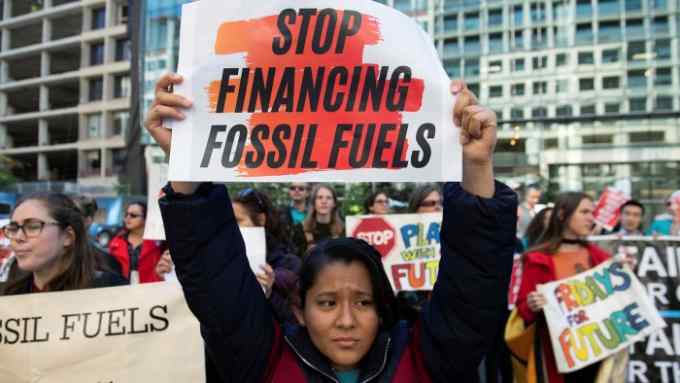Why politics limits climate ambitions

Simply sign up to the Climate change myFT Digest -- delivered directly to your inbox.
The world’s governments have done only a fraction of what is needed to limit the global temperature rise to 1.5C, or even 2C, above pre-industrial levels. Why is this, when the science of climate change is so clear?
First, all governments are driven mainly by politics at home
Cutting greenhouse gas emissions means acting across the whole economy: electricity generation, heating, transport and so on. The policies to do so will often incur short-term costs, or concern influential groups who fear they will lose out, such as coal and oil producers, or farmers wanting to cut down trees for agriculture. These perceived losers are today’s domestic voters.
A positive development is that affordable low-carbon solutions are emerging. Electricity from renewable energy, such as wind and solar, is now cheaper in much of the world than coal. Similarly, electric vehicles are forecast to be cheaper than petrol-powered cars in the next few years. But the transition is complex: for instance, countries worry that reliance on renewables will leave them without energy when there is no sun or wind.
Countries argue about how to share the burden of reducing emissions
Emerging economies are now responsible for the bulk of global emissions (China alone is a bigger emitter than the US, the EU and Japan combined), and some of them have very high emissions per head, even on a historical basis. But, under pressure from the developed world to cut their emissions, these countries argue that rich countries have a long history of burning fossil fuels and have emitted more per head over the past century.
Big emerging economies, such as China, India and Brazil, face other immediate priorities — driving economic growth and tackling poverty, for example — and say developed countries should provide them with financing to support their carbon cutting. They point out that developed countries, including the US, Japan and Canada, have missed their own targets in the past.
Many of the poorest and most vulnerable countries require support to help them adapt to the effects of climate change, which are already being felt. Some are pressing for action on “loss and damage” — problems that they cannot adapt to, including loss of territory.
The consensus is that the developed world should lead in cutting its emissions and provide finance. But precisely what that means remains highly contested.
COP26 made some progress
Governments last met to discuss climate change at COP26, the UN conference, in Glasgow in November. About 90 per cent of the world’s emissions are now covered by net zero emissions targets by 2050-2070. But such goals can merely be statements of broad intent.
More stories from this report
Young people are on the frontline of this fight
We must pay the cost of carbon if we are to cut it
Why the greenhouse effect matters
The rise of ‘extreme weather attribution’
Carbon counting: how much do your lifestyle choices cost the planet?
Liz Thomas: my career drilling ice cores in Antarctica
Climate tech investment boom offers hope
With the exception of Australia, big, developed countries made stronger commitments to cut emissions by 2030: the US, a 50 per cent reduction; the EU, 55 per cent; Japan, 46-50 per cent; Canada, 40-45 per cent; the UK, 68 per cent. Yet none of these countries has the policies in place, so far, to deliver these targets. So they will need to be held to account.
Big emerging economies, apart from South Africa, made only very modest changes to their targets — China included. Some did not change targets at all (Indonesia); or even weakened them (Brazil and Mexico).
What do these changes mean in aggregate? The Climate Action Tracker study estimates that the new 2030 targets could mean the world is on course for a temperature rise of nearer 2.4C. If you assume long-term goals will be met, then it might be more like 2.1C — which is much better than if there had been no action, but not nearly enough to put us on track for 1.5C.
At COP26 in Glasgow, parties agreed that all countries should revisit and strengthen their 2030 targets by the end of 2022. Another important goal was finance, but developed countries failed to meet their goal of mobilising $100bn a year to developing countries by 2020. Only a quarter of the money that did come was for adaptation; developed countries committed in Glasgow to doubling adaptation funding by 2025.
What will the next COP at Sharm el-Sheikh in November achieve?
There is little evidence to suggest that countries will raise the ambition of their 2030 targets. In Egypt, the focus may turn to finance and adaptation, with pressure on developed countries to demonstrate a plan for achieving their targets.
The war in Ukraine is already leading to surging prices for oil, gas and metals, and also for food. This will affect the developing world most severely. But the conflict is likely to affect all countries’ broader energy strategies. Senior politicians in Europe have emphasised the need to end dependence on fossil fuel imports from Russia through a dramatic expansion of renewables. Some in the US argue for an increase in domestic oil and gas production and, in China, there are signs of an increased reliance on home-produced coal.
All have a shared interest in tackling climate change. However, global ambition is heavily influenced by the politics in each major economy. International co-operation is vital and current geopolitics will not help. There is reason to be optimistic, though: the costs of acting continue to fall, and governments, businesses, investors and individuals are seeing more opportunities for doing so.
Teacher questions
Which two factors make co-ordination over action on climate change so challenging?
To what extent were the Paris and Glasgow climate change conferences a positive step?
How useful is the “tragedy of the commons” as a concept to explain why co-ordinating international action is so tough?
Jal Patel, editor of alevelpolitics.com
More at ft.com/politicsclass
The writer is a visiting professor in practice at the Grantham Research Institute, London School of Economics

Comments